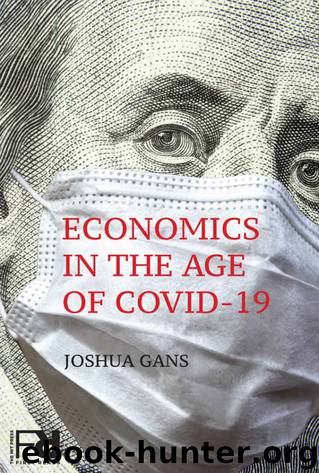Economics in the Age of COVID-19 by Joshua Gans

Author:Joshua Gans [Gans, Joshua]
Language: eng
Format: epub
Publisher: The MIT Press
Published: 0101-01-01T00:00:00+00:00
Nolte cherished one form of capital above all. In 1806, three months after his arrival in New Orleans, he was bitten by a tiny mosquito and fell sick with yellow fever, the most terrifying disease in the Atlantic World.... Nolte survived his “acclimation.” And now what had made him sick made him strong. He possessed “immunocapital”: socially acknowledged lifelong immunity to a highly lethal virus, providing access to previously inaccessible realms of economic, political, and social power.14
In New Orleans an acclimation certificate was a key asset that determined whether you could engage in economic activity. Indeed, it was so valuable that many immigrants arriving actively tried to get sick, as this would be a ticket to economic prosperity and marriage if they survived.15 Unfortunately, without a test, it turned out that the best way to become certified was to prove that you lived in a yellow fever–affected area for more than two years.
Contrary to the options available in the nineteenth century, in order to make the labor market safe again at some point, most countries will likely need to deploy HAD tests widely. Those who are found to have the requisite antibodies can then be certified safe. Obviously, this will require careful recording and verification of HAVE test results as well. Then some method of identifying the safe individuals will need to be devised. All this is within the realm of our current institutions and technology, but setting up the apparatus will likely be costly and require some time.16 Indeed, one could imagine innovative ways of rationing access to such tests when they are scarce—say, by testing in conjunction with blood donations, thereby encouraging that activity as people try to establish their immunocapital.
The question that will arise is what to do with people who do not test positive for HAVE or HAD. One option is for them to remain isolated, but the difficulty here is that there is no obvious end date for that policy. Another policy would be to have guidelines and other preventative measures imposed on those people that limit their interactions with other people who have negative HAVE tests, because if one of those people does end up contracting the disease, they would be able to transmit it to other people who have not yet had it. Overall, the right policy will depend on the proportion of people who test negative. If few people test negative, those negative-testing people are safer as they return to normal economic life because their chances of interacting with other nonimmune people are reduced. Moreover, the tests can assist in certifying people for interactions with high risk to others such as older people or in high-contact fields such as healthcare.
Nonetheless, the downside and potentially unavoidable consequence of moving to a testing economy in this way is that it will reduce social cohesion. Just as the beef producers who worried that having some producers become certified as BSE safe would cause producers who were not certified to be seen as unsafe, we should
Download
This site does not store any files on its server. We only index and link to content provided by other sites. Please contact the content providers to delete copyright contents if any and email us, we'll remove relevant links or contents immediately.
POP by Steven Heller(3307)
Japanese Design by Patricia J. Graham(3108)
The Power of Broke by Daymond John(2896)
Architecture 101 by Nicole Bridge(2763)
Indistractable: How to Control Your Attention and Choose Your Life by Nir Eyal(2331)
Fusion 360 for Makers by Lydia Sloan Cline(2308)
Batik by Rudolf Smend(2123)
Actionable Gamification: Beyond Points, Badges, and Leaderboards by Yu-kai Chou(2122)
Origami Art by Michael G. Lafosse & Richard L. Alexander(2064)
Homebody by Joanna Gaines(2030)
Whiskey in a Teacup by Reese Witherspoon(1935)
Worn in New York by Emily Spivack(1926)
Feng Shui by Stephen Skinner(1900)
Austin Kleon by Steal Like an Artist(1884)
Simple Gatherings by Melissa Michaels(1855)
Don't Make Me Think, Revisited: A Common Sense Approach to Web Usability by Steve Krug(1825)
Hygge: The Danish Art of Happiness by Marie Tourell Søderberg(1693)
The Joy of Hygge by Jonny Jackson(1683)
The Laws of Simplicity by John Maeda(1568)
